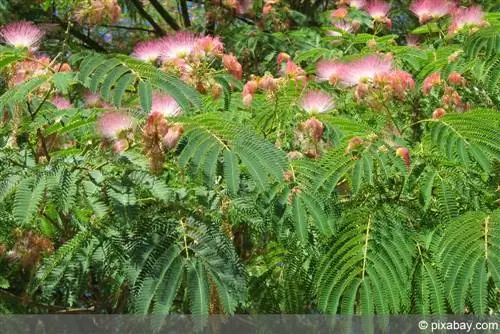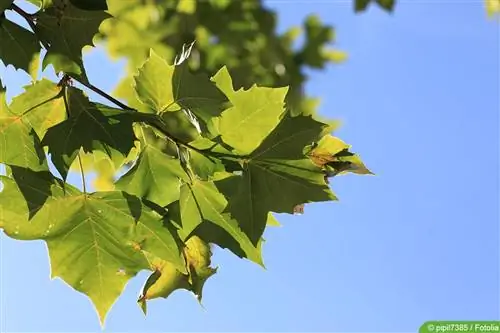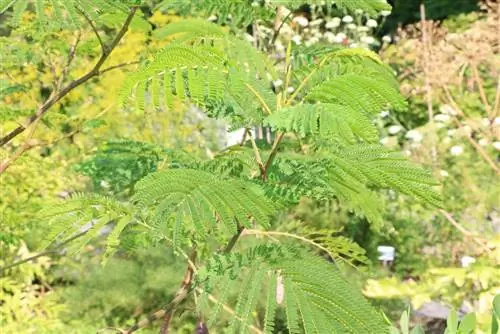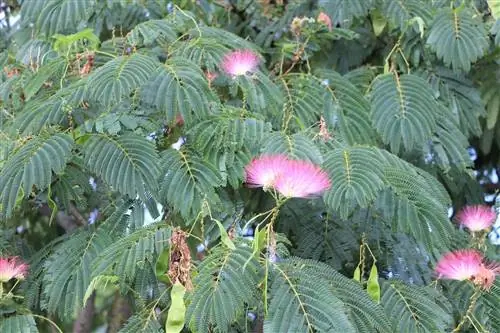- Author admin [email protected].
- Public 2023-12-17 03:39.
- Last modified 2025-01-24 12:45.
The silk tree Albizia julibrissin is also known as the silk acacia or sleeping tree. The main reason for this is its curious foliage, which is somewhat reminiscent of the robinia. When night falls, its leaves fold up, a fascinating spectacle that occurs every day. The sleeping tree grows as a tree or large shrub and, depending on the growth form, can reach heights of 3 - 8 m. At least as spectacular and unique are its flowers, which can be seen from afar with their long, silky, shiny stamens.
cultivation
After flowering, which lasts from June to August, Albizia julibrissin approx.15 cm long, bean-like fruit pods containing the seeds. If stored appropriately, they can germinate for up to 5 years. To grow a sleeping tree, you can use self-harvested seeds or seeds from garden shops. Even scavenged seeds must be freed from the dry fruit pods. Even if sowing would be possible all year round, early spring, around February, is the best time.
- First soak the seeds in lukewarm water overnight or 12 hours
- Pre-swelling is intended to facilitate and accelerate germination
- Then fill the growing container with commercially available growing soil
- Mix the soil with sand or perlite for better permeability
- Now spread the seeds on top
- Seeds of the silk tree germinate in light, so only cover them minimally with soil
- Moisten the substrate and keep it evenly moist until germination
- Covering with translucent film or glass creates optimal germination conditions
- Remove the cover briefly every day to avoid mold formation
- Now place in a bright and warm place without direct sunlight until germination
With constantly moist substrate and temperatures around 25 degrees, germination usually occurs within a few days. As soon as the young seedlings have a few leaves, they can be separated. When they have reached a size of at least 20 cm, they can be planted in their final location.
Location
The silk tree Albizia julibrissin feels most comfortable in warm and partially shaded to sunny locations without heat accumulation, be it in a pot or planted out in the garden. A place in direct or blazing sun should be avoided as it causes heat stress for this extraordinary plant. On the other hand, if it is too dark, it will lose its leaves. What you also don't get are cold north and east winds. The wood of this plant is relatively brittle and fragile, which could cause problems, especially in strong winds or storms. Consequently, a wind-protected location is particularly important.
When choosing a location, you should also take into account the final height of a maximum of 10 m and the sprawling crown shape of the sleeping tree, especially if it is to be planted near a house wall. In our latitudes, the silk acacia is mainly kept in pots and overwintered frost-free. In particularly warm locations, such as wine-growing areas, it can also be left permanently in the garden or planted there with appropriate protection.
Floor
The soil should be loose, well-drained, nutrient-rich and humus-rich. Heavy soils would promote waterlogging, which the silk tree cannot tolerate as well as dry soil. The permeability can be improved by mixing in coarse particles such as gravel, grit or lava grit as well as humus or plenty of sand.
Sandy-gravelly and at the same time humus-rich as well as moderately dry to fresh soils with a neutral to slightly acidic pH value are optimal for this tree. In addition, the silk acacia has a good lime tolerance.
When kept in a pot, we recommend high-quality pot plant soil that can store both water and nutrients well. For better drainage or permeability of the substrate, coarse-grained components can also be added here. The addition of coco humus has proven to be effective for better structural stability, which also optimizes storage capacity.
Tip:
Planting in slightly sandy soil can improve the frost hardiness of planted sleeping trees.
Plants
Even if the deciduous, exotic-looking Albizia julibrissin can be planted in the garden in some regions, it should always be kept in a pot in the first few years due to its limited frost hardiness.
- Water the ball thoroughly before planting
- To plant in the garden, first dig a planting pit
- It should be about twice as deep and about three times as wide as the root ball
- Loosen the soil at the bottom of the planting hole
- Insert appropriate drainage material depending on the soil condition
- Insert a support post when planting the silk tree
- Support post ensures straight growth and makes growing easier
- Water thoroughly after planting
- When planting in containers, make sure the pot and drainage holes are sufficiently large
- The size of the pot should correspond to that of the root ball
- It should offer the roots enough space and not restrict them
- Place a drainage layer of coarse gravel at the bottom of the planter
- Pour in some of the substrate and insert the plant
- Fill the pot with soil up to approx. 3 cm below the edge and water
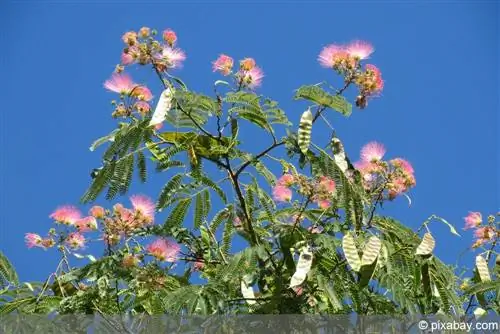
Specimens in the pot are repotted into fresh substrate and a larger pot about every 2-3 years, or as soon as the pot has strong roots. It is sufficient if the new pot is approx. 3-5 cm larger in diameter than the old one. Even when planting in a container, it is advisable to initially attach a support. This decorative tree can develop its full splendor in a pot, as a solitary tree and house tree or as indoor greenery in an unheated winter garden.
Care requirements
Even if the name silk tree suggests otherwise, it has nothing to do with silk production. Its name refers to the long, creamy white, pinkish-colored stamens of the elegant flowers, which shine in the sun like precious silk. The tree or shrub, which belongs to the mimosa family, is a little more demanding than most other ornamental trees when it comes to care. The main focus is on correct watering behavior and overwintering.
Pouring
The water requirement of the silk acacia is relatively high. The soil should be consistently moderately moist throughout the growing season. Freshly planted trees or bushes in particular should be watered regularly in the first few weeks after planting, ideally with rainwater. Taking into account the natural rainfall, the soil should be thoroughly moistened about 2-3 times a week, with the emphasis on 'deep'.
This applies to planted silk trees as well as to potted plants; they also depend on constant soil moisture. Potted plants usually need to be watered daily in summer. If you water too little, no water can reach the lower roots and they die. However, you shouldn't water too much, because too much moisture leads to root rot and also promotes diseases and pest infestation.
Tip:
You should avoid using saucers and planters for potted plants if possible, as they could promote the development of root rot.
Fertilize
In contrast to the water requirement, the need for nutrients is rather low. A silk acacia planted in the garden is happy with a thin layer of ripe compost in spring. The compost is distributed evenly over the root area. A special property of this plant enables it to supply itself with nitrogen and thus enrich the soil. What is meant is a symbiosis with so-called nodule bacteria (nitrogen-binding bacteria) that the silk tree enters into.
This natural fertilization improves your resistance. When fertilizing potted plants, it is sufficient to apply a high-quality liquid fertilizer approximately every two weeks from April to September.
Cutting
The silk tree Albizia julibrissin is usually visually most beautiful when it is not trimmed. This is when the typical, umbrella-shaped, overhanging crown, the pinnate leaves and the delicate flowers come into their own. Nevertheless, thin and weak shoots, which form especially when kept indoors, can be cut out from time to time, which can then also help maintain the he alth of the plant.
If you want to specifically influence the shape or the tree has become too big, you can cut it back without any problem. Shortening or trimming young plants more often stimulates growth. Many new shoots are formed on the shortened shoot tips, which in turn promotes branching. Older, heavily decayed plants can also be cut back to the old wood if necessary. The best time to prune is in late winter, before the new shoots appear.
Wintering
In the first few years, silk trees should always be cultivated in a pot and overwintered in a frost-free place, as they are only hardy to a limited extent. Only with increasing age does their frost hardiness increase, so that depending on the region and climate they can then be planted in the garden and overwintered there with appropriate protection.
- As soon as the outside temperature falls below 10 degrees, potted plants should be brought into the house
- The move to a frost-free, cool and bright winter quarters is coming up
- Temperatures during the winter are around 8 degrees at best
- During the winter, this deciduous plant loses all of its foliage
- As a result, overwintering can also be a little darker
- Provide silk tree with water even in winter
- Pour significantly less and only sporadically
- Root balls should never dry out completely
- There is no fertilization in winter
Older trees and bushes outdoors are hardy down to minus 15 degrees and, depending on the location, can do without protection. In younger specimens, the root area should be protected from frost by covering it with dry leaves and brushwood.
Tip:
The trunks of young dormant trees should be shaded with fleece or conventional jute in the first few years to protect against frost cracks in the bark. Cracks in the bark occur especially when the plants are permanently exposed to the winter sun.
Propagate by cuttings
To propagate, cut 10 - 15 cm long, non-flowering, half-woody head shoots in summer and remove all leaves in the lower area. To accelerate root formation, you then put the interface into a rooting hormone and then into small pots with moist potting soil. Covering with a translucent plastic bag promotes a warm, moist microclimate necessary for root formation.
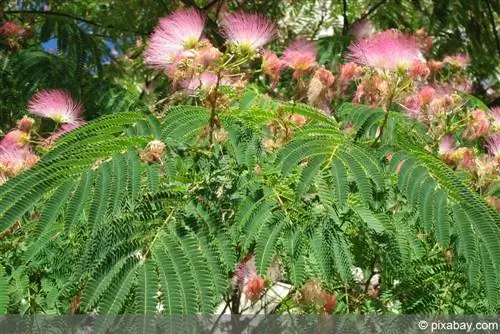
Keep the substrate slightly moist until rooting and place the pots in a bright and warm place without direct sunlight. Every now and then the film needs to be removed and the whole thing ventilated to avoid mold and rot. If the first shoots appear, the rooting was successful and the cover can be removed. When the pots are completely rooted, the young plants can be repotted.
Diseases and pests
Root rot
At nightfall, the silk acacia folds its leaves as if by magic, a characteristic feature of this plant. However, if the leaves do not close at night, this can be an indication of root rot. It is usually accompanied by wilting of the leaves and a musty smell near the ground. In most cases the plant dies. Too much moisture is responsible for this.
For potted plants, you can try to combat root rot by immediately removing water, loosening the substrate with gravel and treating with a suitable fungicide. Smaller specimens can be saved if necessary by repotting them as quickly as possible, removing the rotten root parts and holding off on watering for now.
If the infestation is advanced, the affected plant can usually no longer be saved. It's always best not to let things get to that point by watering as needed, avoiding or improving heavily compacted soils and making sure that potted plants have good drainage in the pot.
Scale insects
Infestation with scale insects occurs primarily during overwintering that is too warm and the air is too dry. A scale insect infestation can be recognized by the small brownish shields, especially on the leaf axils. To combat it, retailers offer various oil-based preparations. To help, you can wipe or wipe them off with a cloth soaked in alcohol or a cotton swab. In addition, natural enemies such as parasitic wasps and lacewings, which like to eat this pest, can be used.
Conclusion
The silk acacia is undoubtedly one of the most fascinating and elegant ornamental trees. The leaves that close in the dark and the delicate flowers are a real natural spectacle that inevitably captivates viewers. Even though growing and maintaining this extraordinary plant is not easy, it is worth every effort and is rewarded with its unique appearance.

